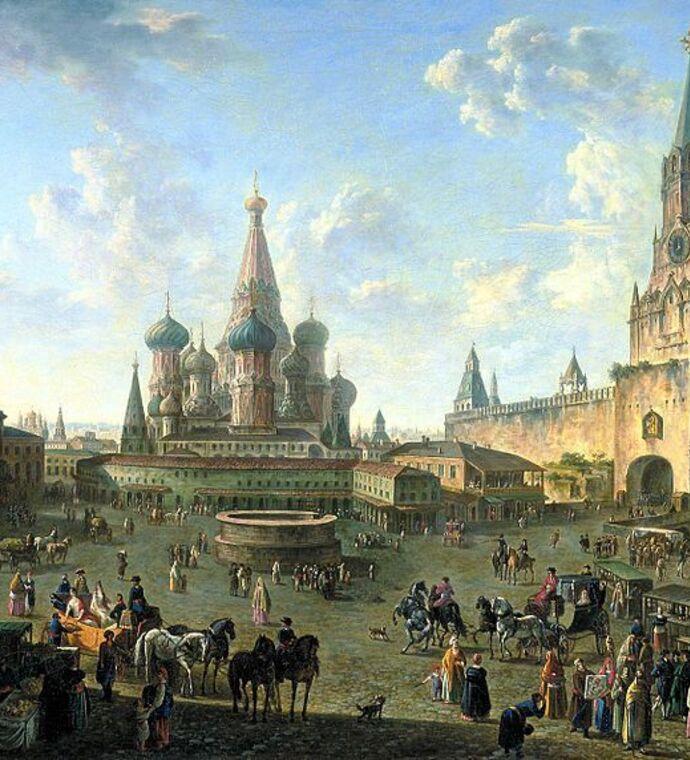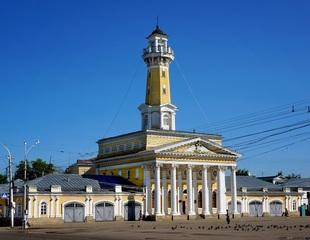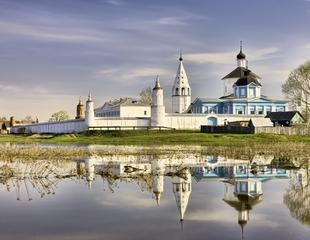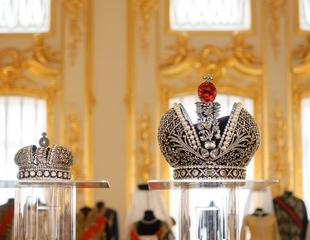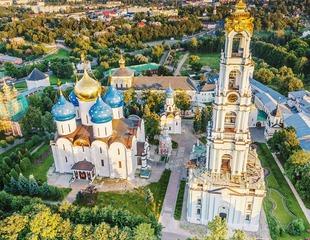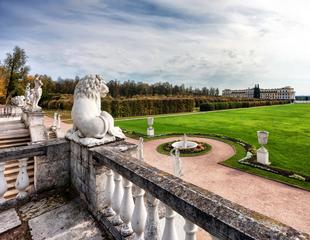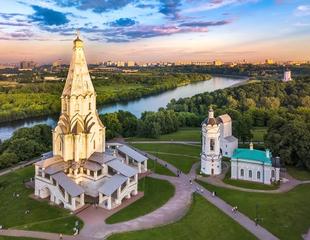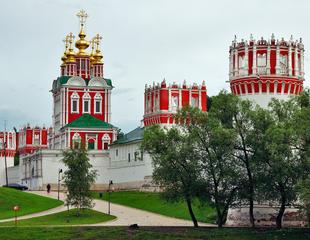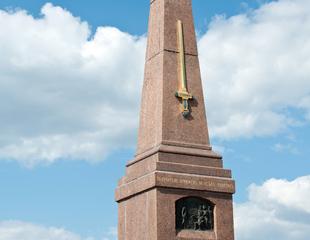Ancient Russia
In fact, early Russia was not exactly a country but a number of Slavic cities in the Eastern and Southern parts of Europe. According to the legend, in the early part of the 9th-century Scandinavian people known as the Varangians crossed the Baltic Sea and landed in Eastern Europe. The leader of the Varangians was the semi-legendary warrior Rurik, who led his people in 862 to the city of Novgorod on the Volkhov River.
Kievan Russia
From Novgorod, Rurik's successor Oleg extended the power southward. In 882, he gained control over Kyiv, a Slavic city that had arisen along the Dnepr River around the 5th century. Oleg's attainment of rule over Kyiv marked the first establishment of a unified, dynastic state in the region. Kyiv became the center of a trade route between Scandinavia and Constantinople, and Kievan Russia as the unified state came to be known.
By 989 Oleg's great-grandson Vladimir I became a ruler of a kingdom that extended to as far south as the Black Sea, the Caucasus Mountains, and the lower reaches of the Volga River. Having decided to establish a state religion, Vladimir carefully considered a number of available faiths and decided upon Greek Orthodoxy, thus allying himself with Constantinople and the West.
Vladimir was succeeded by Yaroslav the Wise, whose reign marked the apogee of Kievan Russia. Yaroslav codified laws, made shrewd alliances with other states, encouraged the arts, and all the other sorts of things that wise kings do. Unhappily, he decided, in the end, to divide his kingdom among his children and bidding them cooperate and flourish. Of course, they did nothing of the sort.
Within a few decades after Yaroslav's death (in 1054), Kievan Russia had broken up into regional power centers. Internal divisions were made worse by the depredations of the invading Cumans (better known as the Kipchaks). By this time Moscow, the small settlement that would soon become the pre-eminent city in Russia was first mentioned in chronicles.
Tatar-Mongol yoke
Kievan Russia struggled on into the 13th century but was decisively destroyed by the arrival of a new invader, the Mongols. In 1237 Batu Khan, a grandson of the famous Genghis Khan carried out an invasion into Kievan Russia. Over the next three years the Mongols, or Tatars, nearly destroyed all of the major Russian cities with the exceptions of Novgorod and Pskov. The regional princes were not deposed, but they were forced to send regular tribute to the Tatar-Mongol State, which became known as the Empire of the Golden Horde.
Invasions of Russia at that time were conducted from the west as well, by the Swedes (1240) and then by the Livonian knights (1242), a regional branch of the Teutonic Union. However, they both were defeated by the great warrior Alexander Nevsky, a prince of Novgorod who earned his surname from the victory over the Swedes on the Neva River.
When the Tatars controlled the southwest of Russia, the northeastern cities gradually gained more influence. These cities were Tver at first, and then, around the turn of the 14th century, Moscow. As a sign of the city's importance, the patriarchate of the Russian Orthodox Church was transferred to the city, making it the spiritual capital of Russia. By the latter part of the century, Moscow felt strong enough to challenge the Tatars directly, and in 1380 Muscovite prince Dmitri Donskoy attacked them. His decisive victory at Kulikovo Field immediately made him a popular hero, though the Tatar retaliation two years later maintained their rule over the city.
Moscow Rus
It wasn't until 1480, after another century had passed, that Moscow was strong enough to throw off the Tatar rule. It was Grand Duke Ivan III, better known as Ivan the Great, who ruled Moscow at that time. Ivan tore up the charter binding it to the Tatar tribute. After doing so, he was effectively in control of the whole country. However, it wasn't until the reign of his grandson, Ivan IV, or Ivan the Terrible, that Russia became a unified state again.
Famous Ivan the Terrible succeeded his father Vasily III as Grand Duke of Moscow in 1533 at the age of three. His mother served as a regent until she died when Ivan was eight. For the next eight years, the young Grand Duke endured a series of regents chosen from among the boyars, or the nobility. Finally, in 1547, he adopted the title of tsar and set about crushing the power of the boyars, reorganizing the military, and preparing to smite the Tatars. He conquered and sacked Kazan in 1552 and Astrakhan in 1556, having thus destroyed the lingering power of the Golden Horde. Ivan's Tatar campaigns opened vast new areas for Russian expansion, and it was during his reign that the conquest and colonization of Siberia started.
By the 1560s he carried out a pretty horrific campaign against the boyars, confiscating their land and executing or exiling those who displeased him. In 1581, in a rage, he struck his son and heir Ivan with an iron rod, killing him.
Time of Troubles
When Ivan the Terrible died in 1584, he was succeeded by his son Fyodor, who was not exactly up to filling the shoes of an autocratic legend. Fyodor left most of the management of the kingdom to his brother-in-law, Boris Godunov. And it was not long before Godunov began to work to secure the succession for himself. In 1591 he murdered Fyodor's younger brother Dmitri in the ancient town of Uglich, a spot now marked by the magnificent Church of St. Demetrius on the Blood. When Fyodor died in 1598, Godunov was made tsar, but his rule was never accepted as entirely legitimate. Within a few years, a pretender arose in Poland, claiming to be Dmitri, and in 1604 he invaded Russia. Godunov died suddenly the next year, and the «Time of Troubles» began. For the next eight years, both the first and the second false Dmitri laid claims to the throne, both supported by invading Polish armies.
Romanov dynasty
Finally, in 1613, the Poles were ousted from Moscow, and the boyars elected Mikhail Romanov as a tsar. The Romanov dynasty was to rule Russia for the next 304 years. For the first few generations, the Romanovs were happy to maintain the status quo in Russia. They continued to centralize power, but they did very little to bring Russia up to speed with the rapid changes in economic and political life that were taking place elsewhere in Europe. Peter the Great decided to change all of that.
Peter was his father's youngest son and the child of his second wife, neither of which promised great things. He spent about two years on a Grand Tour of Europe, not only meeting monarchs and conducting diplomacy but also traveling incognito and even working as a ship's carpenter in Holland. He amassed a considerable body of knowledge on western European industrial techniques and state administration and became determined to modernize the Russian state and to westernize Russian society. The following day after his arrival Peter began his program to recreate Russia in the image of Western Europe by personally clipping off the beards of his nobles. Peter's return to Russia and assumption of personal rule hit the country like a hurricane. He banned traditional Muscovite dress for all men, introduced military conscription, established technical schools, replaced the church patriarchy with a holy synod answerable to himself, simplified the alphabet, tried to improve the manners of the court, changed the calendar, changed his title from Tsar to Emperor, and introduced a hundred other reforms, restrictions, and novelties, all of which convinced the conservative clergy that he was the antichrist. In 1703 he embarked on the most dramatic of his reforms, which was the decision to transfer the capital from Moscow to a new city to be built from scratch on the Gulf of Finland. Over the next nine years, at tremendous human and material cost, St. Petersburg was created.
Peter himself died in 1725, and he remains one of the most controversial figures in Russian history. He was deeply committed to making Russia a powerful new member of modern Europe. Certainly, he modernized Russia's military and its administrative structure, but both of these reforms were financed at the expense of the peasantry, who were increasingly forced into serfdom. After Peter's death, Russia went through a great number of rulers in a distressingly short time, none of whom had much of an opportunity to leave a lasting impression. Many of Peter's reforms failed to take root in Russia, and it was not until the reign of Catherine the Great that his desire to make Russia into a great European power was in fact achieved.
Catherine the Great continued Peter the Great's reforms and increased control over the provinces. Her skill as a diplomat, in an era that produced many extraordinary diplomats, was remarkable. Russia's influence in European affairs, as well as its territory in Eastern and Central Europe, was increased and expanded. Catherine was also an enthusiastic patron of the arts. She built and founded the Hermitage Museum, commissioned buildings all over Russia, founded academies, journals, and libraries, and corresponded with the French encyclopedists, including Voltaire, Diderot, and d'Alembert.
When Catherine the Great died in 1796, she was succeeded by her son Paul I. Paul's reign lasted only five years and was by all accounts a complete disaster. His most notable legacy is the remarkable and tragic Engineer's Castle in St. Petersburg.
Paul was succeeded by his son Alexander I, who is remembered mostly for having been the ruler of Russia during Napoleon Bonaparte's Russian Campaign. In June of 1812, Napoleon began his fatal Russian campaign which ended with Napoleon's downfall and Russia's status as a leading power in post-Napoleonic Europe. Even as Russia emerged more powerful than ever from the Napoleonic era, its internal tensions began to increase.
In the 19th century, Russia expanded its territory and its power. Its borders extended to Afghanistan and China, and it acquired extensive territory on the Pacific coast. The foundation of the port cities had opened up profitable avenues for commerce. And the construction of the Trans-Siberian Railway (constructed in 1891-1905) linked European Russia with its new eastern territories.
In 1894 Nicholas II acceded to the throne. He was not the most competent of political leaders, and his ministers were almost uniformly reactionaries. To make matters worse, the increasing Russian presence in the Far East provoked the hostility of Japan. In January 1905, the Japanese attacked, and Russia experienced a series of defeats. Nicholas was forced to grant concessions to the reformers, including most notably a constitution and a parliament. The power of the reform movement was founded on a new and powerful force that entered Russian politics. The industrialization of the major western cities and the development of the Batu oil fields had brought together large concentrations of Russian workers, and they soon began to organize into local political councils or soviets. In large it was the power of the soviets, united under the Social Democratic party, that had forced Nicholas to accept reforms in 1905.
After the war with Japan was brought to a close, Nicholas attempted to reverse the new freedoms, and his government became more reactionary than ever. Popular discontent gained strength, and Nicholas countered it with increased repression, maintaining control but worsening relations with the population. In 1912 the Social Democrats split into two camps, the radical Bolsheviks and the comparatively moderate Mensheviks. In 1914 another disastrous war once again brought on a crisis. The First World War, however, took place right on Russia's western doorstep. Unprepared militarily or industrially, the country suffered demoralizing defeats, severe food shortages, and in the end an economic collapse. By February of 1917, the workers and soldiers had had enough. Riots broke out in St. Petersburg, which was then called Petrograd. Workers' soviets were set up, and the Duma approved the establishment of Provisional Government to attempt to restore order in the capital. It was soon clear that Nicholas possessed no support, and on March 2 he abdicated the throne in favor of his brother Mikhail. No fool, Mikhail renounced his claim the next day.
Revolution
The Provisional Government, set up by the Duma, attempted to pursue a moderate policy, calling for a return to order and promising reform of worker's rights. However, it was unwilling to endorse the most pressing demand of the soviets — an immediate end to the war. For the next 9 months, the Provisional Government, first under Prince Lvov and then under Alexandr Kerensky, unsuccessfully attempted to establish its authority. In the meanwhile, the Bolsheviks gained increasing support from the ever more frustrated soviets. On October 25, led by Vladimir Ilyich Lenin, they stormed the Winter Palace and deposed the Kerensky government.
Although the Bolsheviks enjoyed substantial support in St. Petersburg and Moscow, they were by no means in control of the country as a whole. They succeeded in taking Russia out of the war (though on very unfavorable terms), but within months civil war broke out throughout Russia. For the next three years, the country was devastated by civil strife, until by 1920 the Bolsheviks had finally emerged victorious. The first few years of Soviet rule were marked by an extraordinary outburst of social and cultural change.
USSR
Lenin's death in 1924 was followed by an extended and extremely divisive struggle for power in the Communist Party. By the latter part of the decade, Joseph Stalin had emerged as the victor, and he immediately set the country on a much different course. Agricultural lands were collectivized, creating large, state-run farms. Industrial development was pushed along at breakneck speed, and production was almost entirely diverted from consumer products to capital equipment. Religion was violently repressed, as churches were closed, destroyed, or converted to other uses. Stalin purged all opposition to himself within the party as well as all opposition to party policy in the country. By the end of the 1930s, the Soviet Union had become a country in which life was more strictly regulated than ever before.
WWII
With the outbreak of World War II, the Soviet Union found itself unprepared for the conflict. Although its non-aggression pact with Germany (1939) served for a while to forestall an attack by Hitler, the Soviets were caught by surprise by the invasion of June 1941. By the end of the year, the Germans had seized most of the Soviet territory in the west, surrounded St. Petersburg (having been renamed once again as Leningrad), and advanced to within a few hundred miles of Moscow. With tremendous effort, a Russian counter-offensive pushed back the advance on the capital, but in the summer of 1942 the Germans carried out a new invasion against the southern front in an attempt to gain control of the rail center of Stalingrad on the Volga and the vital Caucasus oil fields. Despite an overwhelming disadvantage in numbers and inferior weaponry, the Russian army succeeded in holding out against the enormous German army. In November, a relieving force managed to encircle the attackers and compel the surrender of the entire force, marking a decisive turning point in the war. And after the legendary Stalingrad battle, the Russian army remained on the attack. By 1944 they had driven the Germans back to Poland, and on May 2, 1945, Berlin fell.
The Cold War
The Soviet Union emerged from World War II considerably stronger than it had been before the war. Although the country suffered enormous devastation and lost more than twenty million lives, it had gained considerable territory and now ranked as one of the two great world powers along with the United States. Industrial production was once again concentrated on heavy industry, agricultural failures produced widespread famine, political freedoms were restricted even further, and another huge wave of purges was carried out. As the Cold War got underway, an increasing proportion of the Soviet Union's resources were funneled into military projects, further exacerbating the quality of life. Stalin remained in power until 1953 when he died.
Almost immediately after the death of Stalin, many of the repressive policies that he had instituted were dismantled. Under the leadership of Nikita Khrushchev, political controls were to some degree relaxed, and cultural life experienced a brief period of revival. However, opposition to Khrushchev gradually gained strength within the party, and in 1964 he was ousted. By the 1970s, Leonid Brezhnev, as general secretary of the Communist Party of the Soviet Union (CPSU), had become the next prominent Soviet leader. The country entered a decade-long period of stagnation, its rigid economy slowly deteriorating and its political climate becoming increasingly pessimistic. When Brezhnev died in 1982 he was succeeded as a general secretary first by Yuri Andropov, the head of the KGB, and then by Konstantin Chernenko, neither of whom managed to survive long enough to effect significant changes. In March of 1985, when Mikhail Gorbachev became general secretary, the need for reforms was pressing.
Perestroika
Gorbachev's platform for the new Soviet Union was based on two now-famous terms — glasnost (openness) and perestroika (restructuring). Like Khrushchev, Gorbachev intended to resuscitate the Soviet economy by loosening up a bit on social control, opening some room for new ideas, relaxing control of the economy, and generally allowing for a little fresh air. Restructuring began in earnest with a vigorous housecleaning of the bureaucracy and a significant investigation into corruption.
For the first time in decades, the problems of the country became subjects for open public discussion. Poverty, corruption, the enormous mismanagement of the country's resources, the unpopularity of the Afghan war, and a host of other problems and grievances were raised. Radical reform leaders emerged, including the new Moscow Party chief Boris Yeltsin, and prominent dissidents like Andrei Sakharov were able to voice their views for the first time. For some peculiar reason, the government found that it was the target of most of the criticism, but it also found that it wasn't any longer in such a position to do anything but try to move with the flow of events.
In 1990 the Soviet Union began to unravel. Its own constituent republics began to issue declarations of independence. In the Russian Republic, Yeltsin was elected chairman of the Parliament, taking a lead in the independence movement. Gorbachev, caught between popular demands for more radical reform and party demands for the re-imposition of strict control, failed to satisfy either side.
The Russian Federation
The following summer, the radical reform movements became strong enough to openly defy the government. By the end of the year, the Soviet Union had been voted out of existence, to be replaced by a Commonwealth of Independent States (CIS). On December 25, Gorbachev resigned, and at midnight of December 31, the Soviet flag atop the Kremlin was replaced by the Russian tricolor.
